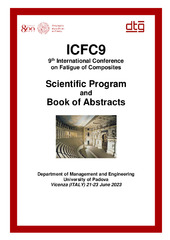| dc.creator | Obradović, Vera | |
| dc.creator | Sejkot, Petr | |
| dc.creator | Machalická, Klára V. | |
| dc.creator | Vokáč, Miroslav | |
| dc.date.accessioned | 2023-12-29T07:37:49Z | |
| dc.date.available | 2023-12-29T07:37:49Z | |
| dc.date.issued | 2023 | |
| dc.identifier.uri | http://TechnoRep.tmf.bg.ac.rs/handle/123456789/7070 | |
| dc.description.abstract | In this research, the testing specimens were made from the Kevlar fabrics impregnated with 10
wt.% poly (vinyl butyral)/ethanol solution but with the addition of the TiO2 nanoparticles. The
tensile and bending properties of the dry specimens were compared with the ones that had been
immersed in a water bath filled with distilled water (40°C) in the period of 8 weeks.
The PVB/fabric weight ratio for the impregnation of the woven Kevlar fabric was 20 wt.%. The
Kevlar/PVB fabric composites were reinforced with the TiO2 nanoparticles in different
concentrations (1 wt.% or 2 wt.% of reinforcement regarding poly (vinyl butyral), PVB). The
two layers of composite fabrics were hot-pressed by using the digital press at a temperature of
170 °C for 30 minutes.
The immersion of the square Kevlar/PVB composite specimens for the water weight gain
measurements was performed according to the ISO 62 standard. The Kevlar/PVB specimens
were tested in accordance with the ASTM D 3039 standard for the tensile properties and ASTM
D 790-03 standard for the flexural properties.
During the tensile and the flexural test, the complete fracture of the specimens did not occur.
The addition of 2 wt.% TiO2 nanoparticles produced 39.8% and 24.3% improvement in the
tensile strength and tensile modulus, respectively, compared to the dry Kevlar/PVB specimens
without reinforcement. The tensile properties of all the immersed Kevlar/PVB composite
specimens had decreased values compared to the ones of their dry specimens.
Unlike the tensile test results, the best flexural properties (strength and modulus) were achieved
with the dry specimens with no particles due to the better bonding between their two
impregnated fabric layers since the presence of TiO2 nanoparticles reduced the shear
connection between the layers. However, there was not such a decline in the properties of the
wet specimens with nanoparticles which even made some improvement in the bending strength
compared to the wet Kevlar/PVB specimens. | sr |
| dc.language.iso | en | sr |
| dc.rights | openAccess | sr |
| dc.rights.uri | https://creativecommons.org/licenses/by/4.0/ | |
| dc.source | Scientific Program and Book of Abstracts / 9th International Conference on Fatigue of Composites (ICFC9), Vicenza, University of Padova, 21-23 June 2023 | sr |
| dc.subject | Kevlar fabrics | sr |
| dc.subject | Tensile testing | sr |
| dc.subject | Bending testing | sr |
| dc.title | Environmental durability of Kevlar composites reinforced with TiO2 nanoparticles | sr |
| dc.type | conferenceObject | sr |
| dc.rights.license | BY | sr |
| dc.citation.spage | 48 | |
| dc.identifier.fulltext | http://TechnoRep.tmf.bg.ac.rs/bitstream/id/19379/Environmental_durability_pub_2023.pdf | |
| dc.identifier.rcub | https://hdl.handle.net/21.15107/rcub_technorep_7070 | |
| dc.type.version | publishedVersion | sr |

